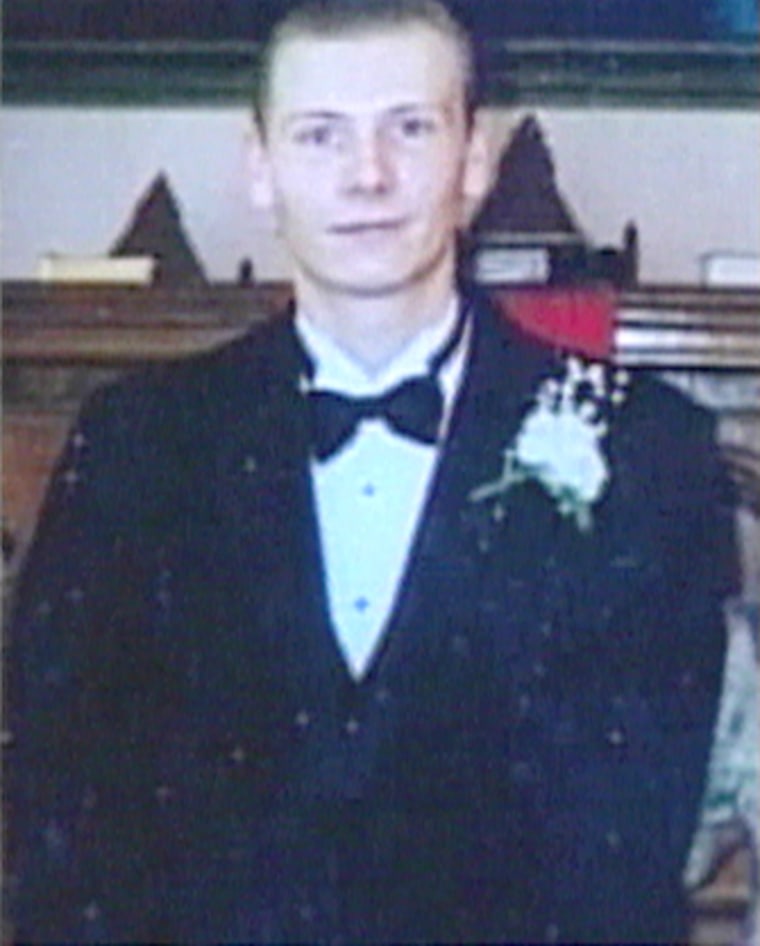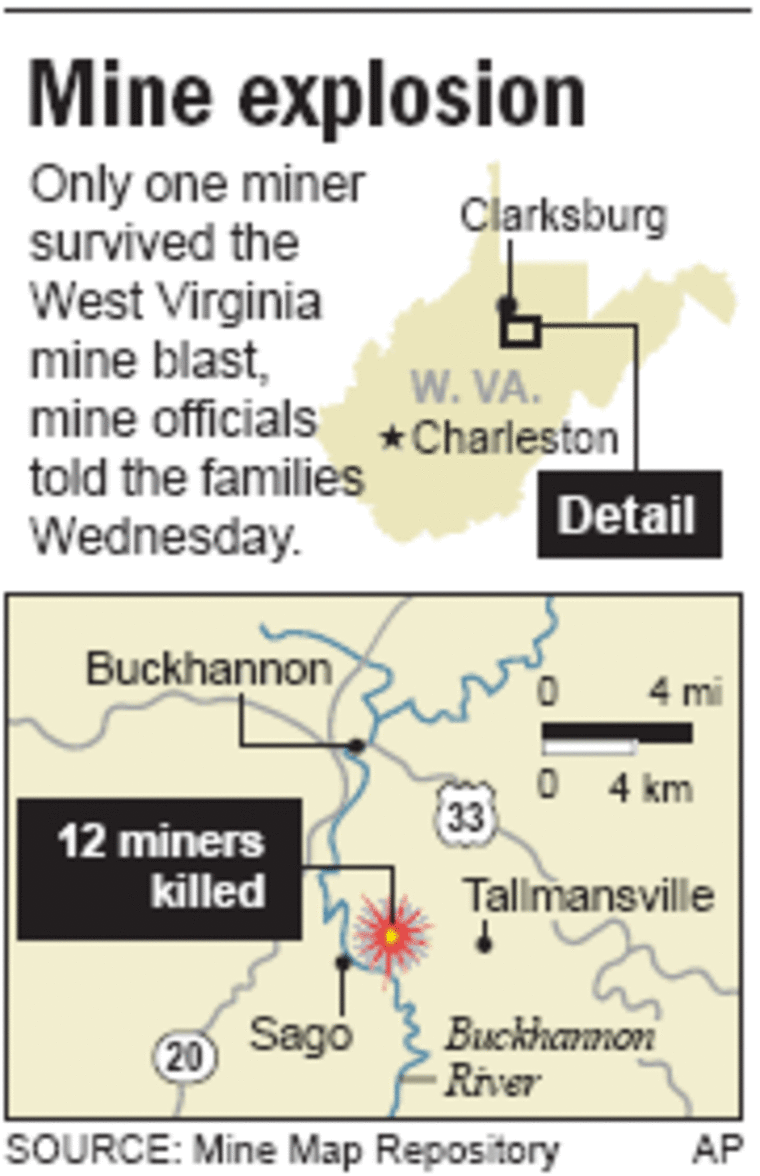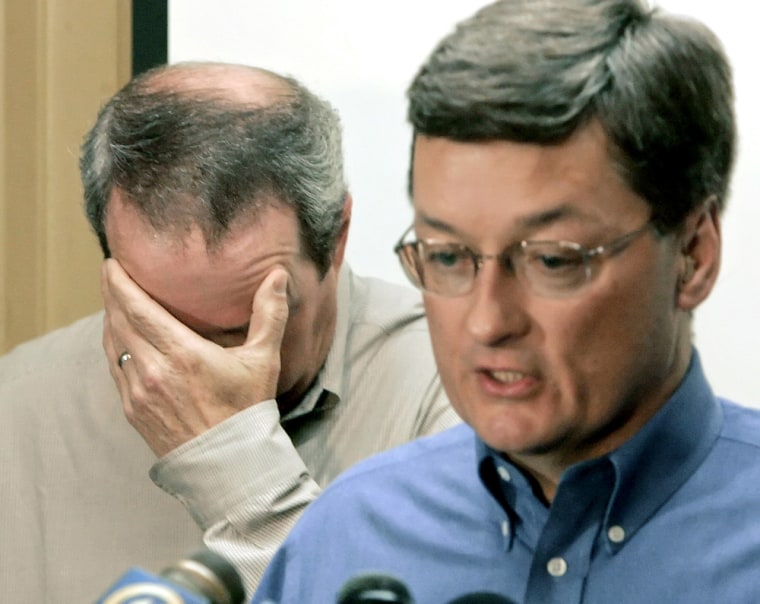A top coal company official expressed regret Wednesday that the families of the 12 dead miners were mistakenly led to believe for three hours that their loved ones were alive.
“In the process of being cautious, we allowed the jubilation to go on longer than it should have,” said a choked-up Ben Hatfield, chief executive of mine owner International Coal Group.
Hatfield said the initial mistake resulted from a miscommunication among the rescue crews. Another ICG executive, vice president Gene Kitts, suggested that the misunderstanding resulted because the rescuers who reached the victims in the mine were wearing full-face oxygen masks and used radios to report their findings to their base.
Hatfield said that overnight, after it appeared that the miners may not be alive after all, the company sent word that the initial report of 12 survivors might have been wrong. But he said the message never got to the family members at the time.
He said the mine company did the best it could under extreme stress and exhaustion, and the owners “sincerely regret” that the families were left to believe for so long their loved ones were alive.
Most survived the explosion
According to officials, most of the 13 coal miners trapped in the explosion on Monday morning survived the blast itself, then retreated deeper into the mine and hung up a curtain-like barrier to keep out toxic gases while they waited to be rescued.
The sole survivor, Randal McCloy, was in critical condition with a collapsed lung and dehydration but no sign of brain damage or carbon monoxide poisoning after being trapped for more than 42 hours, a doctor said. At 27, McCloy was one of the youngest in the group.
The last of the 12 bodies were taken out of the mine at midmorning.
One of the dead was found at least 700 feet from where the others had barricaded themselves in the maze-like mine, officials said. Hatfield said the miner was apparently killed by the force of the blast.
The cause of death for the other men was not immediately disclosed. But McCoy and the 11 others did as they were trained to do, and huddled behind a fabric barrier they had set up to keep out carbon monoxide gas, which had been detected in deadly concentrations inside the mine, Hatfield and state officials said.
The fabric — designed specifically for use as a gas barrier in an accident — was stretched across an area about 20 feet wide, Hatfield said.
Also, each of the miners in the barricaded area had a breathing apparatus that purifies the air and had been able to use it, according to mine officials.
How long they survived was not immediately disclosed. But on Tuesday morning, rescuers drilled a narrow hole near the spot and got no response when they banged on a steel pipe and listened for an answer.
It was the nation’s deadliest coal mining disaster in more than four years.
Families furious
Late Tuesday night, families began streaming out of the church, yelling “They’re alive!” The church bells began ringing and families embraced, as politicians proclaimed word of the apparent rescue a miracle. Gov. Joe Manchin among those who announced there were 12 survivors.
But the families’ joy instantly turned to fury when they found out that 12 were dead.
When the bad news was delivered to the families, “there was no apology. There was no nothing. It was immediately out the door,” said Nick Helms, son of miner Terry Helms, one of the dead.

Chaos broke out in the church and a fight started. About a dozen state troopers and a SWAT team were positioned along the road near the church because police were concerned about violence. Witnesses said one man had to be wrestled to the ground when he lunged for mining officials.
“I can only say there was no one who did anything intentionally other than risk their lives to save their loved ones,” Manchin told ABC’s “Good Morning America.”
“No one can say anything about that would make anything any better,” he said. “Just a horrible situation.”
Survivor in critical condition
McCloy was reported to be unconscious but moaning when he arrived at the hospital. He was in the intensive care unit at West Virginia University’s Ruby Memory Hospital at Morgantown. Doctors said he was under sedation and on a ventilator to help with his breathing.
“He responds to stimuli and that’s good,” Dr. Lawrence Roberts said. Most of the other miners were in their 50s, and doctors said McCloy’s youth may have helped him survive.
Words from Bush
Charles Green, McCloy’s father-in-law, told ABC that when he found out his son-in law was the only survivor, “I was still devastated. My whole family’s heart goes out to them other families.”
President Bush said the entire nation mourns the loss, and he saluted the rescuers “who risked their lives to save those miners for showing such courage.”
Sen. Edward Kennedy, D-Mass., called for hearings to determine how the tragedy happened, according to NBC News.
“We owe it to these miners and their families to find out what happened and whether this accident could have been prevented,” Kennedy said. “In addition, we should investigate the troubled history of repeated safety violations at the mine.”
Reps. George Miller, D-Calif., and Major Owens, D-N.Y., echoed the need for a probe, saying the Sago Mine in West Virginia was cited for over 200 safety violations in 2005.
The miners had been trapped 260 feet down in the Sago Mine, which is shaped like a large backward “F” and situated about 100 miles northeast of Charleston. As rescue workers tried to reach the men, families waited at the Sago Baptist Church during a grueling vigil.
Explosion to be investigated
State and federal officials said they were launching investigations into the cause of the blast. Coal mine explosions are typically caused by buildups of naturally occurring methane gas or highly combustible coal dust in the air.

David Dye, who heads the Mine Safety and Health Administration, said the investigation will include “how emergency information was relayed about the trapped miners’ conditions.”
The explosion was West Virginia’s deadliest coal mining accident since 1968, when 78 men — including Manchin’s uncle — died in an explosion at a mine in Marion County, an hour’s drive from here. Nineteen bodies remain entombed in the mountain. It was that disaster that prompted Congress to pass the Mine Health and Safety Act of 1969.
It was the nation’s worst coal mining disaster since a pair of explosions tore through a mine in Brookwood, Ala., on Sept. 23, 2001, killing 13.
Manchin, who had earlier said that the state believed in miracles, tried to focus on the news that one had survived. “We’re clinging to one miracle when we were hoping for 13,” he said.
